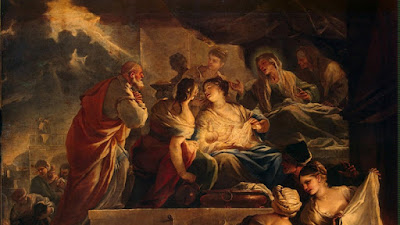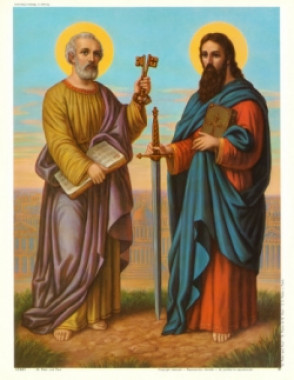We are currently in the Octave of St. John the Baptist, which lasts from the Feast of St. John the Baptist's Nativity on June 24th through the Octave Day on July 1st. This is a Common Octave, meaning that the Mass and Office of St. John the Baptist during the Octave days gives way to any feast day above the level of Simple. In practice, the only intra octave day where the Mass of St. John would be celebrated, rather than merely commemorated, would be on June 27th. The other intra octave days would be outranked by the liturgical feasts already on the Calendar of Saints.
Brief History of Octaves:
By the 8th century, Rome had developed liturgical octaves not only for Easter, Pentecost, and Christmas but also for the Epiphany and the feast of the dedication of a church.
After 1568, when Pope Pius V reduced the number of octaves (since by then they had grown considerably), the number of Octaves was still plentiful. Octaves were classified into several types. Easter and Pentecost had "specially privileged" octaves, during which no other feast whatsoever could be celebrated. Christmas, Epiphany, and Corpus Christi had "privileged" octaves, during which certain highly ranked feasts might be celebrated. The octaves of other feasts allowed even more feasts to be celebrated.
To reduce the repetition of the same liturgy for several days, Pope Leo XIII and Pope St. Pius X made further distinctions, classifying octaves into three primary types: privileged octaves, common octaves, and simple octaves. Privileged octaves were arranged in a hierarchy of first, second, and third orders. For the first half of the 20th century, octaves were ranked in the following manner, which affected holding other celebrations within their timeframes:
- Privileged Octaves
- Privileged Octaves of the First Order
- Octave of Easter
- Octave of Pentecost
- Privileged Octaves of the Second Order
- Octave of Epiphany
- Octave of Corpus Christi
- Privileged Octaves of the Third Order
- Octave of Christmas
- Octave of the Ascension
- Octave of the Sacred Heart
- Privileged Octaves of the First Order
- Common Octaves
- Octave of the Immaculate Conception of the BVM
- Octave of the Solemnity of St. Joseph
- Octave of the Nativity of St. John the Baptist
- Octave of Saints Peter and Paul
- Octave of All Saints
- Octave of the Assumption of the BVM
- Simple Octaves
- Octave of St. Stephen
- Octave of St. John the Apostle
- Octave of the Holy Innocents
Traditional Catholics still attached to the pre-1955 Missal will be familiar with the above list of Octaves. We can live out this forgotten Octave by adding to our daily prayers the Collect from the Nativity of the Lord's Precursor.
Collect:
Collect:
O God, Who hast made this day worthy of honor by the birth of blessed John: grant to Thy people the grace of spiritual joys, and direct the minds of all the faithful into the way of eternal salvation. Through our Lord.
















